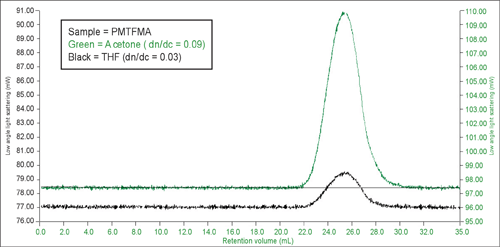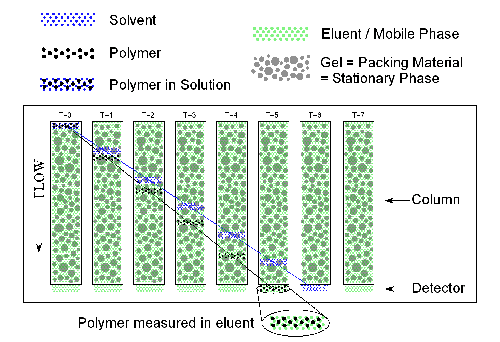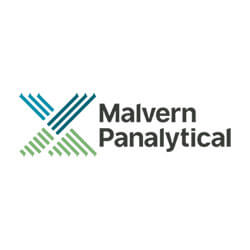Introduction
Viscotek is a strong advocate of good chromatography as a prerequisite for GPC (Gel Permeation Chromatography) data accuracy. Our recent work in application development has been driven by extremely difficult samples from industrial, biopharmaceutical and academic sources. These samples present challenges such as sample solubility, column adsorption as well as detection issues. This report will attempt to highlight a new approach that will be very helpful in certain advanced GPC applications.
Reasons for SELS
Traditionally in GPC, the sample dissolution solvent and the mobile phase are one and the same. However, a closer look at the demands of sample solvent and mobile phase suggests that this should not always be the case. For the sample solvent, one simply wants a solvent that quickly and completely dissolves the sample. Cost and chemical structure are secondary issues. For the mobile phase the requirements are significantly different:
- Because of the high consumption, material cost is a significant factor.
- The dn/dc of the sample in the mobile phase should be as high as possible so that the RI and, especially, the light scattering detector sensitivities are enhanced. In most cases mobile phases with low values of RI will be best.
- The mobile phase does not have to dissolve the sample; only support (or maintain) its solubility during the analysis.
SELS principle
Most low RI solvents, such as acetone and methanol, are weak or non-solvents for mid-to-low polarity polymers. However, they will often support the solubility if the sample is dissolved in a stronger solvent and then diluted or injected into the weaker mobile phase solvent. We call this type of analysis Solvent Enhanced Light Scattering GPC (SELS).Method
The following is a typical SELS example. A particular fluoro-polyester is quite soluble in THF, but the dn/dc is very low in THF. We would like to increase the dn/dc value to get better LS response. We could achieve this in a low refractive index solvent like acetone, however, the sample is not soluble in acetone. By dissolving the sample in THF and injecting the solution into a mobile phase of acetone (the SELS concept), we were able to maximize the accuracy and the reliability of the GPC-LALS analysis while using one of the cheapest and safest mobile phase solvents available.Results
Figure 1 shows the light scattering signal for the polymer in THF. Since the light scattering signal is function of the square of the dn/dc value, the signal is very low for the polymer sample when the system is run in THF (black chromatogram). When the polymer is dissolved in THF but injected in a system running acetone (green chromatogram), the dn/dc value is three times higher. Using acetone as the mobile phase gives a strong signal for the RI and a much stronger signal for the light scattering intensity, making light scattering and triple detection analysis of the fluoro-polyester possible and more importantly, precise and accurate.
Figure 1: Low Angle light scattering (LALS) intensity for a fluoro-polyester dissolved in THF. The black chromatogram is the LALS signal when the solution is injected in a GPC running THF. The green chromatogram is the LALS signal when the same solution is injected in a GPC system running in acetone.

Figure 2: Schematic of SELS where a polymer is injected in solution (blue) but the polymer is measured in a different solvent, the eluent (green).
Malvern provides the materials and biophysical characterization technology and expertise that enables scientists and engineers to investigate, understand and control the properties of dispersed systems. These systems range from proteins and polymers in solution, particle and nanoparticle suspensions and emulsions, through to sprays and aerosols, industrial bulk powders and high concentration slurries. Used at all stages of research, development and manufacturing, Malvern’s instruments provide critical information that helps accelerate research and product development, enhance and maintain product quality and optimize process efficiency. Our products reflect Malvern’s drive to exploit the latest technological innovations. They are used by both industry and academia, in sectors ranging from pharmaceuticals and biopharmaceuticals to bulk chemicals, cement, plastics and polymers, energy and the environment. Malvern systems are used to measure particle size, particle shape, zeta potential, protein charge, molecular weight, mass, size and conformation, rheological properties and for chemical identification, advancing the understanding of dispersed systems across many different industries and applications. www.malvern.com Material relationships http://www.malvern.com/en/ portal@malvern.com






